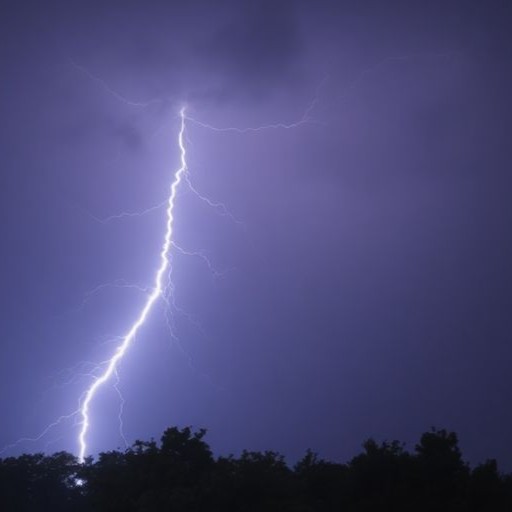Lightning strikes can be both awe-inspiring and terrifying, especially when they threaten your home. Understanding how to protect your home from lightning is crucial, as these powerful electrical discharges can cause significant damage to your property and electronic devices. In this article, we'll explore the hidden dangers of lightning strikes and provide practical tips to safeguard your home against this natural threat.
Key Takeaways
- Lightning can cause severe damage to your home's electrical systems and appliances.
- Immediate actions after a strike include assessing danger, unplugging devices, and inspecting for damage.
- Long-term protection strategies like surge protectors and regular electrical maintenance are essential.
- Installing lightning rods can help, but they have limitations and should not be the only defense.
- Documenting damage for insurance claims is crucial for recovery after a lightning strike.
Understanding the Impact of Lightning on Your Home

Lightning strikes are more than just a cool light show; they can seriously mess with your house. It's good to know what kind of damage to expect so you can be prepared. I've seen firsthand how a single strike can turn a home upside down. Let's break down the main things to watch out for.
The Power of a Lightning Strike
A single lightning bolt packs a punch – we're talking millions of volts and thousands of amps. To give you some context, your wall outlet is only 120 volts. That's why lightning can cause power surges that fry your electronics and even start fires. It's like an electrical tsunami hitting your home's systems.
Common Types of Lightning Damage
Lightning can cause all sorts of problems, from obvious fires to hidden electrical damage. Here's a quick rundown:
- Direct Strikes: Lightning hits your house or a nearby power line, sending a huge surge of electricity straight into your wiring. This is the most destructive type.
- Fires: Lightning can ignite wood, insulation, or anything flammable in its path. These fires can spread quickly, causing major structural damage.
- Power Surges: Even if lightning doesn't hit directly, it can create surges that travel through your electrical system, frying appliances and electronics.
- Structural Damage: The force of a lightning strike can crack foundations, shatter chimneys, and even blow holes in walls.
It's not just the immediate damage you need to worry about. Sometimes, the effects of a strike can show up later, like a slow electrical short or a weakened roof.
How Lightning Affects Electrical Systems
Your home's electrical system is super vulnerable to lightning. The surge of power can overload circuits, melt wires, and destroy sensitive components. Here's what can happen:
- Fried Electronics: TVs, computers, and other devices can be instantly ruined by a surge.
- Damaged Wiring: Wires can melt or short out, creating a fire hazard.
- Appliance Failure: Refrigerators, ovens, and other appliances can be damaged beyond repair.
- Power Outages: Lightning can trip breakers and cause widespread power outages in your home.
Immediate Actions to Take After a Strike
It's easy to panic when lightning hits your house. But knowing what to do immediately can make a big difference. Let's walk through the steps you should take right away.
Assess for Immediate Danger
Your safety is the top priority. If you smell smoke or see any signs of fire, get everyone out of the house immediately and call 911. Lightning can start fires that aren't obvious, like inside walls or in the attic. Don't hesitate – act fast to protect your family and your property. If you are outside, seek lightning protection system.
Unplug Electronic Devices
Lightning strikes can send electrical surges through your home's wiring. To prevent damage to your electronics, unplug them as soon as it's safe to do so. This includes TVs, computers, appliances, and anything else plugged into an outlet. This simple step can save you a lot of money and hassle in the long run.
Inspect for Damage
Once you're sure it's safe to move around, take a look around your property for any visible damage. Check the roof for missing or cracked shingles, look for cracks in the walls, and inspect windows for any signs of shattering. Also, check your electrical panel for tripped breakers. Even if you don't see any obvious damage, it's still a good idea to have a professional electrician inspect your home's electrical system to make sure everything is working properly.
After a lightning strike, it's important to document everything you find. Take photos and videos of any damage, and keep records of any repairs you make. This will be helpful when you file an insurance claim.
Long-term Protection Strategies to Consider
Okay, so you know what to do if lightning strikes. But what about stopping it from causing so much trouble in the first place? Let's look at some ways to protect your place long-term.
Installing Surge Protectors
Think of surge protectors as your first line of defense. They stop those extra jolts of electricity from frying your electronics. You can get them for individual outlets or even a whole-house system. The whole-house ones are wired into your electrical panel and can stop a lot of damage before it even gets inside. It's a good idea to have both, really.
Regular Maintenance of Electrical Systems
It's easy to forget about your electrical system until something goes wrong. But keeping it in good shape can really help. Make sure your wiring is up to code. If you have an older house, it might be worth getting an electrician to check things out. They can spot potential problems before they become big headaches. Also, check your roof and windows regularly. A small leak can become a big problem if lightning causes a power surge.
Grounding Your Home Effectively
Grounding is super important. It gives the electricity a safe path to the ground, away from your house. If your house isn't grounded well, even the best surge protectors won't do much good. Get a pro to check your grounding system, especially if your house is older. It's a small investment that could save you a lot of money and hassle in the long run.
A layered approach is best. Whole-house surge protection, point-of-use protectors, and unplugging devices during storms all add up to better protection. It's like having multiple locks on your door – each one makes it harder for lightning to cause damage.
The Role of Lightning Rods in Protection
How Lightning Rods Work
Lightning rods, also known as air terminals, are designed to provide a safe path for lightning to reach the ground, bypassing the structure of your home. They are typically made of metal, like copper or aluminum, and are installed on the highest points of a building. The rod intercepts the lightning strike, and a grounding system then directs the electricity harmlessly into the earth. It's a bit like a designated exit for a dangerous electrical surge.
Benefits of Installing Lightning Rods
Installing lightning rods can offer several benefits:
- Reduced risk of fire: By diverting the electrical current, lightning rods minimize the chance of a fire starting in your home's structure.
- Protection of electrical systems: While not a substitute for surge protectors, lightning rods can help reduce the strain on your electrical system during a strike.
- Peace of mind: Knowing you have an extra layer of protection can provide comfort during severe storms.
Lightning rods are most effective when part of a comprehensive lightning protection system. This includes proper grounding and surge protection to safeguard all aspects of your home.
Limitations of Lightning Rods
It's important to understand that lightning rods aren't a foolproof solution. They have limitations:
- They don't prevent lightning strikes: Lightning rods attract lightning to a specific point, but they don't stop strikes from happening in the area.
- They require proper installation: A poorly installed lightning rod system can be ineffective or even dangerous. Always use a qualified professional.
- They don't protect against power surges: You still need surge protection to protect your electronics from power surges caused by nearby strikes.
While lightning rods offer a degree of protection, they are not a complete solution. They work best when combined with other protective measures, such as whole-house surge protectors and careful attention to grounding.
Dealing With Insurance After Lightning Damage
Lightning damage is usually covered by homeowner's insurance, but getting a fair settlement can be tricky. Insurance companies need solid proof that lightning, and not just wear and tear, caused the damage. It's all about having your ducks in a row.
Understanding Coverage for Lightning Strikes
Most homeowner's policies do cover lightning damage, but the specifics can vary. It's important to know what your policy covers – things like dwelling coverage, personal property, and even additional living expenses if you have to move out temporarily. Read the fine print, and don't be afraid to call your insurance agent to clarify anything you don't understand.
Documenting Damage for Claims
If lightning strikes, documentation is your best friend.
- Take photos of everything that's damaged, inside and out.
- Make a detailed list of all affected items, including their make, model, purchase date, and estimated replacement cost.
- Keep receipts for any repairs or replacements you make.
Getting a lightning verification report lightning verification report that confirms storm activity in your area can also be super helpful. It's extra evidence that lightning was indeed the culprit.
Working with Your Insurance Adjuster
Your insurance adjuster is the person who will assess the damage and determine how much the insurance company will pay. Be prepared to answer their questions and provide them with all the documentation you've gathered. Don't be afraid to ask questions yourself, and if you disagree with their assessment, you have the right to appeal. If your entire smart home system was compromised, make sure to provide comprehensive documentation. Sometimes, it might be worth getting a public adjuster to help you navigate the claims process and ensure you get a fair settlement. They work for you, not the insurance company, and they know the ins and outs of insurance claims.
Layered Defense Against Lightning Strikes

Whole-House Surge Protection
Think of whole-house surge protection as your first line of defense. These devices are installed at your electrical panel and are designed to divert a significant portion of a surge's energy away from your home's wiring. It's like having a bouncer at the door of your electrical system, turning away the unwanted chaos of a power surge. It's important to remember automatic transfer switch and generator chain.
Point-of-Use Surge Protectors
While whole-house protection is great, it's not foolproof. That's where point-of-use surge protectors come in. These are the power strips you plug your electronics into. They offer an additional layer of protection for your sensitive devices. Think of them as the last line of defense for your most prized possessions. They're especially important for expensive electronics like computers, TVs, and gaming consoles.
Unplugging Devices During Storms
Sometimes, the best defense is the simplest. When a severe thunderstorm is rolling through, consider unplugging your most valuable electronics. It might seem old-fashioned, but it's a surefire way to protect them from a direct lightning strike. No surge protector, no matter how good, can guarantee complete protection from a direct hit.
Unplugging devices during storms is a simple, effective way to add an extra layer of protection. It's a bit like putting your valuables in a safe during a robbery – it might be inconvenient, but it could save you a lot of money and hassle in the long run.
Here's a quick rundown:
- Unplug expensive electronics.
- Consider unplugging appliances.
- Don't forget about cable and satellite boxes.
Recognizing Signs of Lightning Damage
It's not always obvious when lightning has struck your home, even if it wasn't a direct hit. Sometimes the damage is immediate and dramatic, but other times it's subtle and shows up later. Knowing what to look for can help you catch problems early and prevent further issues.
Visible Damage to Structures
One of the first things to do after a storm is walk around your property and look for any visible damage. This could include:
- Cracks in the foundation or walls
- Damaged roofing (missing shingles, holes)
- Charred or burned areas, especially around the roof, electrical boxes, or utility entrances
- Damaged trees or landscaping near the house
Even if you don't see anything obvious, it's worth taking a closer look, especially at points where utilities enter your home. Sometimes the damage is hidden, but the entry points are a good place to start.
Electrical System Failures
Lightning strikes often cause problems with your electrical system. This can range from minor inconveniences to major hazards. Here are some signs to watch out for:
- Flickering lights or power outages
- Tripped circuit breakers that won't reset
- Burning smells coming from outlets or appliances
- Appliances or electronics that suddenly stop working
If you notice any of these, it's important to schedule a professional electrical inspection as soon as possible. Don't try to fix electrical problems yourself unless you're a qualified electrician.
Delayed Effects of Lightning Strikes
Sometimes, the damage from a lightning strike doesn't show up right away. It can take days, weeks, or even months for problems to surface. Here are some delayed effects to be aware of:
- Intermittent electrical problems that come and go
- Increased energy bills due to damaged appliances running inefficiently
- Water leaks caused by damage to plumbing or roofing
- Corrosion or rust on metal components due to electrical surges
It's a good idea to keep an eye on your home's systems after a storm, even if everything seems fine at first. If you notice anything unusual, it's better to err on the side of caution and get it checked out. Remember that lightning causing power surges can affect multiple homes from a single strike.
When lightning strikes, it can cause serious damage that might not be easy to spot right away. Look for signs like burnt marks, damaged electronics, or flickering lights. If you think your home has been hit, don’t wait! Visit our website to learn more about how to check for lightning damage and get help from our experts.
Wrapping It Up: Protecting Your Home from Lightning
So, there you have it. Lightning isn’t just a cool light show; it can really mess up your home and gadgets. We’ve talked about how it can cause power surges that can fry your electronics and even start fires. Living in Texas, where storms are common, means you need to be smart about protecting your stuff. A good plan starts with a whole-house surge protector, and don’t forget to use point-of-use protectors for your valuable devices. And hey, if you can, unplug things during a storm. It’s a hassle, but it’s worth it. Make sure your home’s grounding is up to snuff, too. If you’re unsure, get a pro to check it out. It’s a small price to pay to avoid a big headache later. Stay safe out there!
Frequently Asked Questions
What should I do if lightning strikes my home?
If lightning hits your home, first check for any immediate danger like smoke or fire. If you see any, evacuate and call the fire department. Then, unplug any electronics to prevent damage from power surges.
How can I protect my home from lightning strikes?
You can protect your home by installing surge protectors, maintaining your electrical systems, and considering a lightning rod to direct strikes safely to the ground.
What kind of damage can lightning cause?
Lightning can cause physical damage to your home, like burned areas or broken shingles, and can also harm your electrical systems, leading to appliance failures.
Do I need insurance for lightning damage?
Yes, most homeowners insurance policies cover lightning damage. It's important to check your policy and report any damage as soon as possible.
How can I tell if my home has lightning damage?
Look for visible signs like burn marks, damaged wiring, or malfunctioning electronics. You might also notice electrical system failures or issues that appear later.
What is a lightning rod and how does it work?
A lightning rod is a metal pole placed on top of a building. It provides a safe path for lightning to follow into the ground, reducing the risk of damage to the building.
NEED HELP WITH SURGE PROCTECTION?

GET A FREE QUOTE TODAY
Fill out the form below and we will reach out to you as soon as possible.



